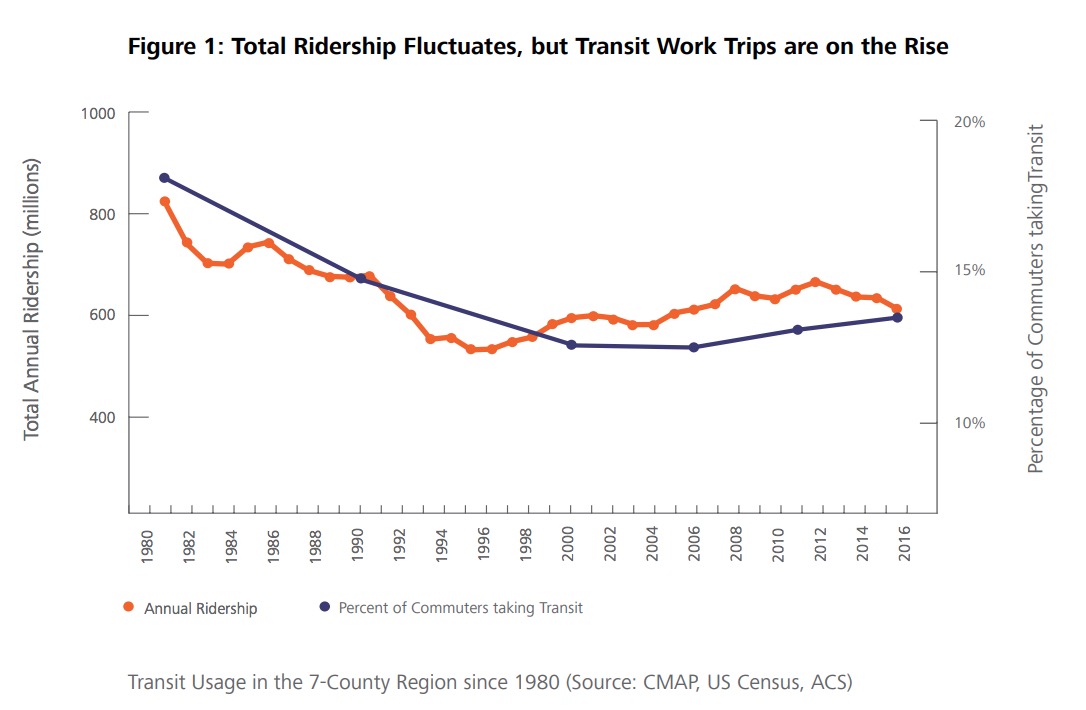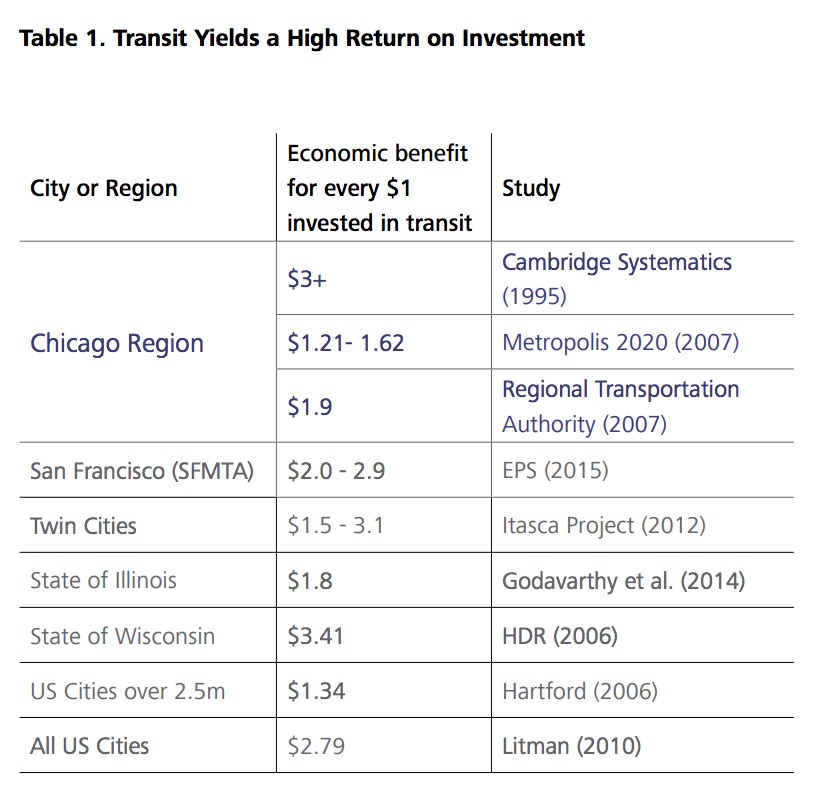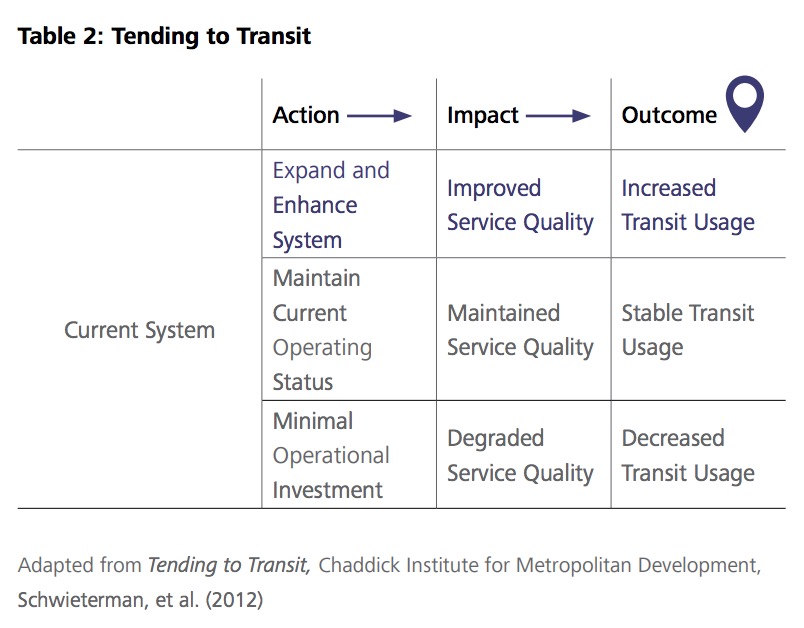METROPOLITAN PLANNING COUNCIL (MPC)
Introduction: Transit Drives Business Decisions
McDonald’s. Caterpillar. Motorola Solutions. These Chicago region-based companies have many things in common:
They employ thousands, help drive our region’s economy, and cite transit as a key factor in their location and recruitment strategy.
Businesses throughout the region rely on and benefit from metropolitan Chicago’s transit system.
However, the critical connection between transit investments and our ability to recruit and retain business in metropolitan Chicago is not broadly understood. With Transit Means Business, the Metropolitan Planning Council (MPC) is bringing together business leaders, transit leadership and state and local government to advocate for stronger investments in our region’s transit system.
The reasons to mobilize now are clear. Businesses are betting on transit, but without sufficient investment the competitive advantage our system provides is eroding and will start to fail. Our metropolitan-wide research shows:
- Businesses are choosing to locate near transit to access larger labor pools;
- Locations near transit offer businesses increased resiliency;
- Transit-accessible locations outperform the regional average on job growth, especially near rail.
This report dives into the data to reveal how transit supports businesses, and profiles companies who are making transit-based decisions that benefit their bottom line.
A growing and thriving transit system means a growing and thriving economy. Decades of research show a well-funded and robust transit system yields many benefits including new jobs, increased worker productivity, better health outcomes and a strong real estate market.
Business in the Chicago region has reaped the rewards of an extensive and well-maintained transit system. To retain those benefits and attract new jobs, it is critical to invest in, adapt and grow transit to meet modern needs.
Transit Has a Net Economic Benefit
Quantifying the economic impacts and benefits of transit
Decades of economic analysis have yielded a singular conclusive finding:
Investing in transit results in regional economic growth.
The studies in Table 1 all calculate benefit-cost ratios for transit investments in urbanized areas. Benefit-cost ratios are a quantification of the economic returns that result from a financial investment. In all cases shown below, the benefit-cost ratio exceeds 1, meaning that $1 invested in transit yields more than $1 in economic benefits. Three Chicago-specific studies conducted over the past two decades all show significant benefits to the region if we were to invest in a state of good repair or expand service. Of all the studies we surveyed, the smallest expected return from investing in transit was 21%. This would be considered a hugely successful investment in the private sector.
Economic benefits to residents, employers and communities
Transit benefits the economic health of the greater Chicago region in a variety of ways. When regions step up their transit investment and transit ridership increases, businesses, households and communities experience the following types of economic benefits:
- Access to talent: Businesses gain access to larger labor markets with more diverse skills, enabled by larger public transit service areas and reduced traffic congestion. Residents can live in a wide variety of locations throughout the region and access well-paid jobs.
- Less traffic: Transit investments reduce roadway congestion for cars and trucks, shortening commutes and improving freight delivery.
- More disposable household income: When more people ride transit, their travel costs are lowered and funds are freed for housing, entertainment and other living expenses.
- More well-paid jobs: Investment in transit attracts more employers to the region. Companies that are looking to locate in world-class regions are increasingly seeking places with robust transit systems. Public transit is seen as a necessary urban amenity for places to compete for workers, conventions and other economic activities.
- Employment from transit system operations and infrastructure investments: The Regional Transportation Authority (RTA), Chicago Transit Authority (CTA), Metra and Pace collectively employed 14,532 full-time people in 2017. These solid middle-class jobs provide a service that enables the region to function. Additionally, construction jobs are created by major transit capital investments that maintain or expand the system. For example, CTA’s new South Terminal at 95th / Dan Ryan created over 760 construction jobs.
When combining all providers together, public transit was the 10th largest employer in the Chicago region in 2017.
- Increased productivity: High-quality transit that speeds travel and allows workers to perform tasks other than driving
- Higher property values: Transit investment often catalyzes residential and commercial property development. Increased property values near transit grow wealth for owners and increase tax revenue. From 2015 to 2017, new CTA stations at Morgan and Cermak-McCormick Place yielded over $2.5 billion in private land investment.
- Equitable and affordable transportation: Nearly 20 percent of RTA transit riders have incomes under $25,000 per year. When lower income groups have improved mobility and access, it generates savings on government services and support programs.
- Reduced vehicle emissions and improved air quality: Transit’s ability to reduce solo drivers and auto emissions improves the environment.
- Reduced fatalities and injuries: Trips shifted from cars to transit reduce traffic-related injuries and deaths, a significant societal cost.
- Improved health outcomes: Transit increases opportunities for active transportation like walking and biking, resulting in a healthier population.
Success breeds success
Expanded investment yields more transit usage, while minimal investment depresses the number of riders. As municipalities and regions grapple with how to keep their transportation infrastructure functioning policy makers face tough decisions about how and where to make investments. The following chart is a simplified framework of how different levels of investment impact ridership. If our region wants more people to use transit — a highly efficient, equitable and sustainable form of transportation — we need to invest in it.
Talent Prefers Transit
Commutes to work on transit are up, despite overall ridership being down
While it’s true that the region has experienced a downward trend in transit ridership since a 20-year high in 2012, that’s not telling the full story. The proportion of commuters taking transit to work has actually seen a small but steady increase for over a decade now, as shown in Figure 1. This suggests that ridership loss may stem from discretionary trips far more than the daily journey to and from work. And considering that the number of jobs in the region increased by over 300,000 from 2005 to 2015, it’s clear that many more people are taking transit to work than any time in recent memory.
Transit commuting is strong and growing for the largest segments of the workforce
 Table 3 shows data on the age composition of the overall workforce and the subset that commute by public transit. By comparing the percent of the total workforce to the percent of total transit commuters, it’s possible to see which age groups are over- or underrepresented among transit commuters. The last two columns show how the different age groups are growing in the overall workforce, and among transit commuters specifically. Workers aged 25 to 44 (which includes the majority of Millennial workers) are the largest part of the workforce, and will be for decades to come. They make up an even larger share of transit commuters, and their numbers are still swelling. The number of workers taking transit in the Millennial cohort grew by 8 percent in the last five years alone.
Table 3 shows data on the age composition of the overall workforce and the subset that commute by public transit. By comparing the percent of the total workforce to the percent of total transit commuters, it’s possible to see which age groups are over- or underrepresented among transit commuters. The last two columns show how the different age groups are growing in the overall workforce, and among transit commuters specifically. Workers aged 25 to 44 (which includes the majority of Millennial workers) are the largest part of the workforce, and will be for decades to come. They make up an even larger share of transit commuters, and their numbers are still swelling. The number of workers taking transit in the Millennial cohort grew by 8 percent in the last five years alone.
Older age groups also have an interesting story to tell. The Boomer generation aged 55 and up makes up 21 percent of the workforce, but only 15 percent of transit commuters. However, Boomers are the fastest growing part of the workforce and they’re taking transit to work in swiftly growing numbers. In the last five years, the number of workers over 55 taking transit grew by an impressive 11 to 13 percent.
Download full version (PDF): Transit Means Business
About the Metropolitan Planning Council (MPC)
www.metroplanning.org
Since 1934, the Metropolitan Planning Council (MPC) has been dedicated to shaping a more equitable, sustainable and prosperous greater Chicago region. As an independent, nonprofit, nonpartisan organization, MPC serves communities and residents by developing, promoting and implementing solutions for sound regional growth.
Tags: Chicago, IL, Illinois, Metropolitan Planning Council, MPC








 RSS Feed
RSS Feed